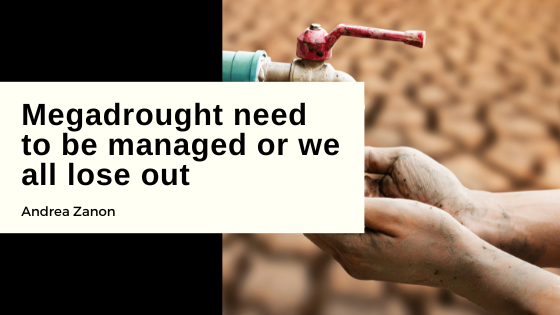Water issues are one of our greatest natural challenges and drought is a more certain near-term risk to Europe and the United States than other natural hazards that policy makers and city managers must focus on. Just to be clear, in developing countries, drought is causing even more devastating impacts. The challenge is that droughts destroy life and economies silently, unlike hurricanes and earthquakes that strike in one day and leave visible and quantifiable damage and losses. Megadroughts are the extreme representation of water stress and are characterized by prolonged periods of dryness that span more than two decades. These have been happening for a long time, but since they affect people and economies very slowly, they are harder to monitor and manage. Water stress has been a challenge way before climate change issues were brought to the front of society over the last thirty years.
At the global level, the U.N. has warned that half the world population will face severe water scarcity by 2030, accelerated by climate change and population unrelentless growth. Water shortages would threaten food production, economic flows, as well as a health emergency which already kills 3,6 million people each year through waterborne diseases. Most of these people are children (2.2 million).
In the United States, according to recent findings, soil moisture deficits doubled in the last 22 years compared with levels in the 1900s. Human-caused warming accounted for a 42% increase in severity and these 22 years have been the driest and hottest on record for the last 1200 years. This was also reported by NASA in late 2021. The exceptional drought has resulted in unprecedented emergency measures in the two largest water reservoirs in the US, lakes Mead and Powell which provide water to about 50 million people in Colorado, Wyoming, Utah, Arizona, Nevada, and New Mexico. In 2021, these reached the lowest level in history reducing supply by 20% to Arizona.
What to do about Megadroughts?
Megadrought is a slow-moving natural hazard (a creeping phenomenon), which destroys livelihoods and economies, but the effects of which often accumulate slowly over a long period of time. Here following are some of the measures that if combined strategically can lead to longer term water resiliency:
- Strategic Resilience: Resilience is about shifting focus to proactive prevention as opposed to reactive response. This is not only cost effective, but it helps economies and people be risk aware and be better prepared to absorb a shock and/or disaster when it materializes, and bounce back quickly returning to normalcy. Corporations and countries that invests in resiliency are able to maintain business continuity, reduce damage and losses and have integrated risk management in decision making.
- Digital Integration: Water management and innovation should be streamlined by making the entire system of bringing water from source to market more efficient and effective. One way to manage and conserve water better is to connect water infrastructure digitally and enable real-time monitoring via sensors and Internet of Things (IOTs). Pipes, meters, wells, treatment plants, filters can become useful once they are integrated into the Internet. Water management and water loss detection becomes a normal business operation.
- Tech and Agriculture: Approximately 80 percent of all water in the United States is consumed by the agricultural sector and the country is moving rapidly to ensure that the sector becomes more efficient in terms of water use. One effective tool that is becoming more common, is the deployment of drones to provide real time imagery for commercial farms, cattle ranches and vineyards. The data collected helps mapping water stress and thus help farmers and growers allocate water resources more efficiently. While the FAA continues to limit the deployment of drones for commercial use, some companies like Precision Hawk and TerrAvion promise to address irrigation/fertilization in wineyards and large scale agriculture projects.
- Desalination and Harvesting: Desalination technology is becoming cost effective. Thanks to massive investment particularly from Saudi Arabia and China we are now able to convert sea water into fresh water that can be used for domestic use. Desalination technology should be combined with systematic water harvesting and storing. As precipitation becomes more sporadic, soil absorption capacity decreases rapidly, and when a downpour happens the water ends up in the ocean. What we should do instead is, build water harvesting and storing systems saving water for periods of needs.
- Wastewater Reutilization: The world must learn how to do more with less water. The Pure Water program in San Diego California, aims to provide more than 40 percent of the city’s water from local sources (via recycling water) by the year 2035. The city aims to produce 83 million gallons a day by then. The idea is to recycle water on a large scale, to manage drought efficiently. Recycling wastewater will enable city dwellers to access al the flow of wastewater, clean it up, and then use it to offset the need for other supplies. For those skeptical about the cleanliness of recycled wastewater, they should know that if they are leaving downstream of a major waterway, they’re already drinking recycled water which often is less pure that this recycled by modern technology.
Conclusions: To manage drought effectively, you must use different tools as outlined above. Water management is expensive, and don’t be fooled, pumping water from the Colorado river to hydrate Californians is not cheap. Water recycling, resiliency and water harvesting are cheap interventions and low regret options for all. As water grows scarcer in the developed world, it will become more expensive and decision makers and businesses have an opportunity to work together to avoid a costly future water stress.

